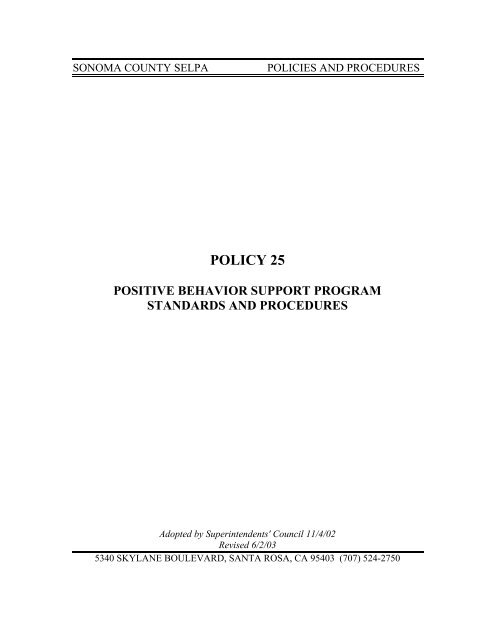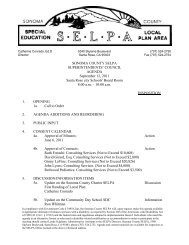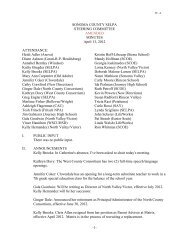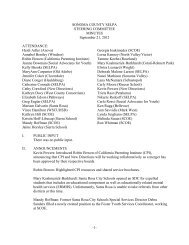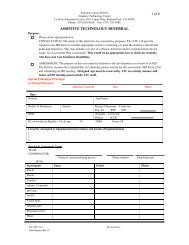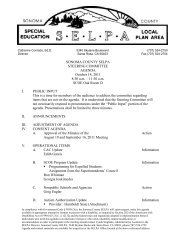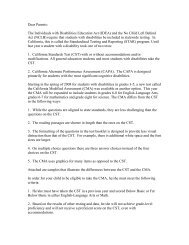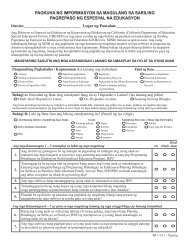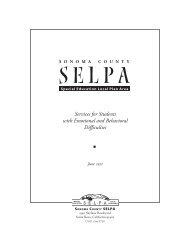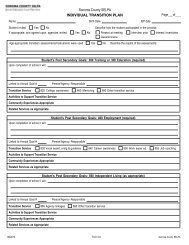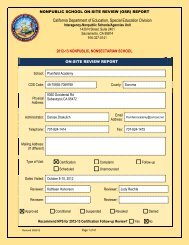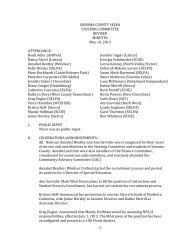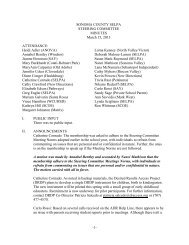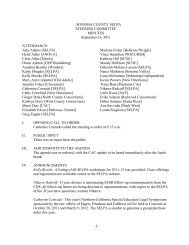Positive Behavior Support Standards and Procedures - Sonoma ...
Positive Behavior Support Standards and Procedures - Sonoma ...
Positive Behavior Support Standards and Procedures - Sonoma ...
You also want an ePaper? Increase the reach of your titles
YUMPU automatically turns print PDFs into web optimized ePapers that Google loves.
SONOMA COUNTY SELPA POLICIES AND PROCEDURESPOLICY 25POSITIVE BEHAVIOR SUPPORT PROGRAMSTANDARDS AND PROCEDURESAdopted by Superintendents' Council 11/4/02Revised 6/2/035340 SKYLANE BOULEVARD, SANTA ROSA, CA 95403 (707) 524-2750
SONOMA COUNTY SELPAPOLICY 25POSITIVE BEHAVIOR SUPPORT PROGRAMSTANDARDS AND PROCEDURESINTRODUCTIONThe <strong>Sonoma</strong> County SELPA has established the <strong>Positive</strong> <strong>Behavior</strong> <strong>Support</strong> program toassist districts in developing effective long-term interventions for special educationstudents with challenging behaviors. The program has two components.1. The utilization of <strong>Behavior</strong> Specialists to support identified children <strong>and</strong> theirfamilies.2. The provision of comprehensive staff development by the <strong>Sonoma</strong> County SELPA insupport of the needs of district staff.The <strong>Sonoma</strong> County SELPA’s <strong>Positive</strong> <strong>Behavior</strong>al <strong>Support</strong>s <strong>and</strong> Interventions policycontains a continuum that describes recommended <strong>and</strong> required interventions based oncurrent research. That policy will be referred to at times within this document.DEFINITION OF POSITIVE BEHAVIOR SUPPORT<strong>Positive</strong> behavior support (PBS) is the application of behavior analysis to achieve sociallyimportant behavior change. PBS was developed initially as an alternative to aversiveinterventions that were used with students with severe disabilities who engaged inextreme forms of self-injury <strong>and</strong> aggression (Dur<strong>and</strong> & Carr, 1985; Meyer & Evans,1989). More recently, the technology has been applied successfully with a wide range ofstudents, in a wide range of contexts (Carr et al., in press; Horner, Albin, & O’Neill,1991), <strong>and</strong> extended from an intervention approach for individual students to anintervention approach for entire schools (Colvin, Sugai, Good, & Lee, 1996; Colvin,Kame’enui & Sugai, 1993; Lewis, Colvin, & Sugai, in press; Lewis, Sugai & Colvin,1998; Taylor-Greene, et al., 1997; Todd, Horner, Sugai, Sprague, 1999; Sugai, Sprague,Horner, Walker, in press).PBS is not a new intervention package, nor a new theory of behavior. Instead, it is anapplication of a behaviorally based systems approach to enhance the capacity of schools,families, <strong>and</strong> communities to design effective environments that improve the fit or linkbetween research-validated practices <strong>and</strong> the environments in which teaching <strong>and</strong>learning occurs. Attention is focused on creating <strong>and</strong> sustaining school environments thatimprove lifestyle results (personal, health, social, family, work, recreation, etc.) for allchildren <strong>and</strong> youth by making problem behavior less effective, efficient, <strong>and</strong> relevant,<strong>and</strong> desired behavior more functional. In addition, the use of culturally appropriateinterventions is emphasized. Haring <strong>and</strong> De Vault (1996) indicate that PBS is comprisedof (a) “interventions that consider the contexts within which the behavior occurs,” (b)SONOMA COUNTY SELPA PAGE 1 OF 13POSITIVE BEHAVIOR SUPPORT PROGRAMAdopted 11/4/02Revised 6/2/03
POLICY 25“interventions that address the functionality of the problem behavior,” (c) “interventionsthat can be justified by the outcomes,” <strong>and</strong> (d) “outcomes that are acceptable to theindividual, the family, <strong>and</strong> the supportive community” (p. 116).PBS moves beyond simply reducing challenging or impeding behavior - to multipleapproaches: changing systems, altering environments, teaching skills <strong>and</strong> focusing onpositive behavior. PBS is based on underst<strong>and</strong>ing why challenging behavior occurs – thebehavior’s function. PBS is first <strong>and</strong> foremost an ongoing problem-solving process thatincludes thorough assessment (specifically called functional behavioral assessment) todesign effective interventions (to reduce impeding behavior(s) <strong>and</strong>/or teach new skills)<strong>and</strong> supports (describing what individual needs to maintain the positive changes with theeffected behavior(s). 1PROGRAM STANDARDSThe goal of the PBS program is to enable schools to deliver socially acceptable, effective,<strong>and</strong> efficient interventions to ensure safe, productive environments where norm-violatingbehavior is minimized <strong>and</strong> prosocial behavior is promoted. 2 To achieve this goal, thefollowing are program st<strong>and</strong>ards based on the PBS definition <strong>and</strong> the SELPA's <strong>Positive</strong><strong>Behavior</strong>al <strong>Support</strong>s <strong>and</strong> Interventions policy.1. School-wide behavioral support system that contains:A. Clearly defined behavioral expectations for all studentsB. Specified reinforcers <strong>and</strong> consequencesC. Clear <strong>and</strong> explicit systems for communication between all members of the schoolcommunityD. <strong>Positive</strong> behavioral support for other areas of the school campus where childrengatherE. Implementation of best practices in classroom operation <strong>and</strong> structureF. Methods of data collection on progress of positive behavioral support systems2. Classroom behavioral support system that contains:A. Clearly defined behavioral expectations for all studentsB. Specified reinforcers <strong>and</strong> consequencesC. Implementation of best practices in classroom operation <strong>and</strong> structureD. Methods of data collection on progress of positive behavioral support systems3. <strong>Support</strong> system for individual students that includes:A. Implementing Student Study (or Success) Teams (SSTs) <strong>and</strong>/or1 Applying <strong>Positive</strong> <strong>Behavior</strong> <strong>Support</strong> <strong>and</strong> Functional <strong>Behavior</strong>al Assessment in Schools, OSEP Center on<strong>Positive</strong> <strong>Behavior</strong>al Interventions <strong>and</strong> <strong>Support</strong>s, 20002 IbidSONOMA COUNTY SELPA PAGE 2 OF 13POSITIVE BEHAVIOR SUPPORT PROGRAMAdopted 11/4/02Revised 6/2/03
POLICY 25B. Implementing a <strong>Behavior</strong> <strong>Support</strong> (or Intervention) TeamC. Utilizing a functional behavioral assessment to develop appropriate individualbehavior support plans (BSP) for children identified as having a behavior thatimpedes his or her learning or the learning of othersD. Completion of the Temporary <strong>Support</strong> Assistant (TSA) forms (TSA DecisionMaking Flowchart <strong>and</strong> Supplementary Services Review for TSA) to determine theextent to which a TSA may be needed for the studentE. Assigning a case manager to each student with a BSP4. A <strong>Behavior</strong> Specialist whose responsibilities include:A. Consultation services to the IEP teamB. Collaborative development of a <strong>Behavior</strong> <strong>Support</strong> Plan (BSP)C. Collaborative Functional Analysis Assessment (FAA) <strong>and</strong> the development of a<strong>Behavior</strong>al Intervention Plan (BIP)D. Local staff developmentE. Collaboration with family <strong>and</strong> other agencies that provide services to studentsThese activities are specified in further detail in this document.5. A Functional Analysis Assessment (FAA) <strong>and</strong> <strong>Behavior</strong> Intervention Plan (BIP) forstudents identified as having one of the following behaviors (Hughes Bill):A. Serious self-injurious behaviorB. Serious assaultive behaviorC. Serious property destructionD. Other severe behavior problems that are pervasive <strong>and</strong> are maladaptive thatrequire a systematic <strong>and</strong> frequent application of behavioral interventions6. Local staff development activities may include:A. School-wide effective behavior support training (e.g. - BEST)B. <strong>Behavior</strong> Intervention Teams (BIT)C. <strong>Behavior</strong> <strong>Support</strong> Plan (BSP) developmentD. Individual school team trainingE. Effective classroom managementF. Parent training7. In addition to st<strong>and</strong>ards 1-6, children who are eligible for Mental Health servicesthrough AB 3632 or Medi-Cal or from other agencies such as North Bay RegionalCenter, the student may receive the following family-centered training <strong>and</strong> support:A. Development <strong>and</strong> implementation of effective strategies in the homeB. Parent trainingC. Wraparound support services to the family <strong>and</strong> childD. Mental Health servicesSONOMA COUNTY SELPA PAGE 3 OF 13POSITIVE BEHAVIOR SUPPORT PROGRAMAdopted 11/4/02Revised 6/2/03
POLICY 25PROCEDURESDistrict ResponsibilitiesPre-referral ProcessPrior to referring a child for <strong>Positive</strong> <strong>Behavior</strong> <strong>Support</strong> Services, the district must hold anIEP meeting (in the child’s classroom, if possible) <strong>and</strong> consider:<strong>Positive</strong> school-wide behavior support systems intended to maximize the child’spositive behavior on a daily basis<strong>Positive</strong> classroom management systems <strong>and</strong> strategies intended to support thechild’s positive behavior throughout the school dayGoals <strong>and</strong> objectives in the child’s IEP that pertain to behavior changeAn implemented behavior intervention or support plan, including a functionalbehavioral assessment <strong>and</strong> replacement skills, <strong>and</strong> a statement of the relativeeffectiveness of the planDescriptions of any previously attempted interventions <strong>and</strong> their relative effectivenessInformation from the child’s parent regarding behavioral <strong>and</strong> academic performanceDescription of the history of parent-school contactCurrent supports available for the teacher <strong>and</strong> student at the school siteObservation data or report provided by the school’s administrator, psychologist, orteacherReferral ProcessA Request for <strong>Positive</strong> <strong>Behavior</strong> <strong>Support</strong> Services form will be completed <strong>and</strong> submittedalong with the following documents <strong>and</strong> information:The child’s most recent IEP documenting parent approval of the referralAll previous behavioral assessments <strong>and</strong> intervention plansModifications <strong>and</strong> adaptations implemented to assist the childA referral for Mental Health services, or an AB 3632 referral, if appropriateThe most recent psychological evaluationOther relevant assessments (speech <strong>and</strong> language, OT, PT, Mental Health, etc.)The child’s daily scheduleA current Individual Transition Plan (ITP) if appropriateThe referral form must include the name of the child’s case manager responsible forcoordinating <strong>and</strong> monitoring the child’s progress <strong>and</strong> services. This is the contactperson for the <strong>Behavior</strong> Specialist. This person may be a special education teacher,psychologist, DIS provider, or administrator.The referral form will include what particular service is being requested, e.g., IEPbasedconsultation, Functional <strong>Behavior</strong>al Assessment <strong>and</strong> <strong>Behavior</strong> <strong>Support</strong> Pl<strong>and</strong>evelopment, Functional Analysis Assessment <strong>and</strong> Hughes Bill development.SONOMA COUNTY SELPA PAGE 4 OF 13POSITIVE BEHAVIOR SUPPORT PROGRAMAdopted 11/4/02Revised 6/2/03
POLICY 25The referral form will be submitted to the SELPA Program Specialist or districtadministrator responsible for overseeing the program for review. If the referral isapproved, the case will be referred to the <strong>Behavior</strong> Specialist <strong>and</strong> to the appropriatedistrict administrator. The district administrator will assign a case manager who willdevelop an assessment plan.<strong>Behavior</strong> Specialist Responsibilities<strong>Behavior</strong> specialists will be responsible for the following services in collaboration withdistrict staff:1. IEP-Driven Consultation ServicesThe <strong>Behavior</strong> Specialist will provide consultation services to the IEP team based onthe team’s request for positive behavioral support services. Features of the ongoingconsultation will include direct observation, interactions with the student, determiningstaff training needs, ongoing discussion/training with all staff implementers,descriptive analysis (defining exhibited behaviors in the environment, examiningfrequency <strong>and</strong> duration), systematic data collection <strong>and</strong> analysis, adjustment ofbehavioral interventions to determine the influence of instructional level, antecedent<strong>and</strong> consequences, collaborative development of a behavior support plan asnecessary, <strong>and</strong> ongoing progress updates. Written recommendations will be based onidentified targeted behaviors <strong>and</strong> descriptive analysis <strong>and</strong> will include generalbehavioral considerations, consideration of services or the completion of a functionalanalysis assessment (FAA). A permission to assess form must be given to the parentby the case manager before this begins.2. Collaborative Development of <strong>Behavior</strong> <strong>Support</strong> Plan (BSP)Based on the data collected during the above activities, a plan to facilitate the use ofalternative behaviors within the setting will be developed. The plan will consist ofpreventive <strong>and</strong> reactive methods for use in the setting that focuses on changing theenvironment in which the behavior occurs <strong>and</strong> teaching the use of alternative orreplacement behaviors. Methods for use in the setting will be broken down intosmaller units for staff <strong>and</strong> child instruction (i.e., a task analysis) <strong>and</strong> then given to thecase manager for implementation. The BSP becomes part of the child’s IEP. Pl<strong>and</strong>evelopment may also include completion of the SELPA Temporary <strong>Support</strong>Assistant forms (TSA Decision Making Flowchart <strong>and</strong> Supplementary ServicesReview for TSA) by the case manager to determine the extent to which a TSA isneeded to support the student’s behavioral needs.3. Collaborative Functional Analysis Assessment (FAA) <strong>and</strong> Development of the<strong>Behavior</strong> Intervention Plan (BIP)SONOMA COUNTY SELPA PAGE 5 OF 13POSITIVE BEHAVIOR SUPPORT PROGRAMAdopted 11/4/02Revised 6/2/03
POLICY 25For Hughes Bill driven FAAs, the district must complete the assessment plan <strong>and</strong> theemergency behavior plan, if necessary (refer to the <strong>Sonoma</strong> County SELPA LocalPlan). Components of the assessment include:Referral <strong>and</strong> record reviewInterviews of critical staff <strong>and</strong> parentsIdentification, definition <strong>and</strong> prioritization of 1-3 target behaviors with staff foranalysisDevelopment of a descriptive analysis of the target <strong>and</strong> replacement behaviorsbased on observation of the student across all impacted environmentsSystematic manipulation of variables in the setting to determine the function ofthe behavior to decrease or increase the likelihood of occurrenceDevelopment of recommendations for IEP team consideration. The FAA report,consisting of data analysis <strong>and</strong> recommendations consistent with Hughes Billrequirements, will be reviewed by the IEP team.Completion of the SELPA Temporary <strong>Support</strong> Assistant) forms (TSA DecisionMaking Flowchart <strong>and</strong> Supplementary Services Review for TSA) to determine theextent to which a TSA may be needed to support the student’s behavioral needs.This form will be completed by the case manager <strong>and</strong> reviewed by the IEP team.At the same IEP meeting, a review of the existing emergency behavior plan (ifappropriate) will be reviewed, an interim intervention plan based on the function ofthe behaviors exhibited will be proposed <strong>and</strong> the development of the <strong>Behavior</strong>Intervention Plan (BIP) will be discussed.4. Local Staff DevelopmentThe school or district may identify specific staff development needs for the <strong>Behavior</strong>Specialist to deliver. The intention is to use the specialist to build the school staffcapacity to support positive behavior through implementation of best practices. Staffdevelopment options are based on the SELPA-wide options listed below.5. Family-Centered Training <strong>and</strong> <strong>Support</strong>Children who are found eligible for services from other agencies (such as MentalHealth or North Bay Regional Center) may be eligible for family training <strong>and</strong> supportprovided by these agencies. This training may include parent training, therapy (asdetermined by the appropriate agency staff), <strong>and</strong> related services. For those childrenfound eligible, the agency personnel will coordinate services with district <strong>and</strong> SELPA<strong>Behavior</strong> Specialists <strong>and</strong> their supervisors.SELPA-WIDE STAFF DEVELOPMENT TRAININGThe <strong>Sonoma</strong> County SELPA will provide staff development to staff to facilitate thesupport of positive behavior. The trainings may include the following for school teams:SONOMA COUNTY SELPA PAGE 6 OF 13POSITIVE BEHAVIOR SUPPORT PROGRAMAdopted 11/4/02Revised 6/2/03
• School-wide Effective <strong>Behavior</strong> <strong>Support</strong> Training (e.g.- BEST)POLICY 25The focus of this type of training is on developing capacity in a school team to assessthe site for appropriate practices, determine rules, methods of acknowledging positivebehavior, methods of correcting behavioral mistakes, developing effective schoolwide,classroom <strong>and</strong> individual support strategies, <strong>and</strong> determining an action plan forimplementing a comprehensive program. An example is Building Effective SchoolsTogether (BEST), a training provided through the State by the Institute on Violence<strong>and</strong> Destructive <strong>Behavior</strong> at the University of Oregon.• <strong>Behavior</strong> Intervention Teams (BIT).This training is provided by the <strong>Sonoma</strong> County SELPA <strong>and</strong> focuses on developing aschool team’s capacity to develop effective individual behavior support plans (BSP)for children with challenging behaviors. Teams learn how to conduct a functionalbehavioral assessment (FBA) <strong>and</strong> to develop a BSP in a student study team model.• <strong>Behavior</strong> <strong>Support</strong> Plan (BSP) development.This training is provided either by the <strong>Sonoma</strong> County SELPA or by Diana BrowningWright of the Southern California Diagnostic Center <strong>and</strong> focuses on building capacityin educational staff <strong>and</strong> administrators to develop effective BSPs. The participantslearn how to develop a 1-2 page BSP that meets the requirements of IDEA.• Individual School Team training.The <strong>Sonoma</strong> County SELPA Program Specialist provides training to staff at anindividual school to address needs unique to that school.• Effective Classroom Management.The <strong>Sonoma</strong> County SELPA provides training in research-based <strong>and</strong> validatedclassroom techniques <strong>and</strong> strategies. Trainings are geared towards classroomteachers <strong>and</strong> administrators.ROLES AND RESPONSIBILITIES OF STAFF BASED ON TYPE OF SERVICEIEP-Driven Consultation ServicesSELPA Program Specialist (for districts contracting with the SELPA) or DistrictAdministrator (for districts who employ their own <strong>Behavior</strong> Specialist):1. Processes Request for <strong>Positive</strong> <strong>Behavior</strong> <strong>Support</strong> Services referral forms, assigns<strong>Behavior</strong> Specialist, if accepted. If denied, the forms are returned to districtadministrator2. Sends notice to special education case manager of start of serviceSONOMA COUNTY SELPA PAGE 7 OF 13POSITIVE BEHAVIOR SUPPORT PROGRAMAdopted 11/4/02Revised 6/2/03
3. Sends notice to <strong>Behavior</strong> Specialist4. Conducts preliminary observation, as warranted5. Provides ongoing support to <strong>Behavior</strong> Specialist <strong>and</strong> case managerPOLICY 25<strong>Behavior</strong> Specialist:1. Contacts case manager to set up on-going services2. Observes student in critical educational environments3. Develops written consultation summary <strong>and</strong> recommendations. These will beprovided to the general <strong>and</strong> special education teacher(s), appropriate support staff, thecase manager <strong>and</strong> SELPA Program Specialist or district administrator.4. Assists in the development <strong>and</strong> monitoring of data collection systems <strong>and</strong> suggestsprogram adjustments as a result of the monitoring5. Provides services to child <strong>and</strong> teachers6. Trains staff as neededCase Manager:1. Coordinates consultation between appropriate staff (psychologist, general <strong>and</strong>/orspecial education teacher, speech, OT/PT <strong>and</strong> <strong>Behavior</strong> Specialist)2. Coordinate meeting, if necessary, to review consultation report <strong>and</strong> recommendations3. Sends written notification regarding progress to SELPA Program Specialist orDistrict Administrator <strong>and</strong> child’s family4. Coordinates attainment of items needed to implement plan5. Sends copy of IEP service pages to SELPA Program Specialist or DistrictAdministrator upon any change in behavior services, including termination6. Develops assessment plan <strong>and</strong> sends it to parentSite Administrator:1. Discusses with parent about <strong>Positive</strong> <strong>Behavior</strong> <strong>Support</strong> services2. Reviews previous disciplinary actions <strong>and</strong> their results3. Participates in IEP meetings4. Conducts or coordinates observation, if necessarySpecial/General Education Staff (teacher, instructional assistant, psychologist, etc.):1. Provides additional information to <strong>Behavior</strong> Specialist2. Implements suggestions3. Collects data as requested by <strong>Behavior</strong> Specialist4. Completes a variety of assessment forms as requested by <strong>Behavior</strong> Specialist5. Collaborates in on-going plan developmentCollaborative Development of <strong>Behavior</strong> <strong>Support</strong> Plan (BSP)SONOMA COUNTY SELPA PAGE 8 OF 13POSITIVE BEHAVIOR SUPPORT PROGRAMAdopted 11/4/02Revised 6/2/03
POLICY 25SELPA Program Specialist (for districts contracting with the SELPA) or DistrictAdministrator (for districts who employ their own <strong>Behavior</strong> Specialist):1. Processes Request for <strong>Positive</strong> <strong>Behavior</strong> <strong>Support</strong> Services referral forms, assigns<strong>Behavior</strong> Specialist, if accepted. If denied, the forms are returned to the districtadministrator2. Sends notice to special education case manager <strong>and</strong> <strong>Behavior</strong> Specialist ofassignment <strong>and</strong> start of service including need to obtain signed Assessment Plan3. Provides ongoing support to <strong>Behavior</strong> Specialist <strong>and</strong> case manager4. Contacts Mental Health manager to assign clinician <strong>and</strong>/or case managementspecialist if applicable<strong>Behavior</strong> Specialist:1. Contacts case manager to set up on-going services2. Observes student in critical educational environments3. Develops <strong>and</strong> implements data collection systems4. Analyzes data5. Co-develops a prevention plan, task analysis for teaching new skills, <strong>and</strong> reactionplan to target behaviors6. Continues data collection development <strong>and</strong> ongoing analysis7. Consults with classroom staff <strong>and</strong> DIS providers8. Coordinates behavior plan with Mental Health staff <strong>and</strong> treatment planCase Manager:1. Coordinates consultation between appropriate staff (psychologist, general <strong>and</strong>/orspecial education teacher, speech, OT/PT <strong>and</strong> <strong>Behavior</strong> Specialist)2. Coordinate meeting, if necessary, to review consultation report <strong>and</strong> recommendations3. Sends written notification regarding progress to SELPA Program Specialist orDistrict Administrator <strong>and</strong> child’s family4. Coordinates attainment of items needed to implement plan5. Sends copy of IEP service pages to SELPA Program Specialist or DistrictAdministrator upon any change in behavior services, including termination6. Develops assessment plan <strong>and</strong> sends it to parentSite Administrator:1. Discusses with parent about <strong>Positive</strong> <strong>Behavior</strong> <strong>Support</strong> services2. Reviews previous disciplinary actions <strong>and</strong> their results3. Participates in IEP meetings4. Conducts or coordinates observation, if necessarySpecial/General Education Staff (teacher, instructional assistant, psychologist, etc.):SONOMA COUNTY SELPA PAGE 9 OF 13POSITIVE BEHAVIOR SUPPORT PROGRAMAdopted 11/4/02Revised 6/2/03
Psychologista. Provides consultation to site staffb. Provides consultation to <strong>Behavior</strong> Specialistc. Observes studentd. Consults with other special education staff on sitee. Conducts assessments as neededPOLICY 25Teacher/Staffa. Implements strategies for prevention, teaching alternative skills, <strong>and</strong> reaction totarget behaviorsb. Collects datac. Develops materials for use in schoolAll Special Education staffa. Provides additional information to <strong>Behavior</strong> Specialistb. Implements suggestionsc. Collects frequency data as requestedd. Completes assessment forms as requestede. Participates in consultation with <strong>Behavior</strong> SpecialistCollaborative Functional Analysis Assessment (FAA) <strong>and</strong> Development of the <strong>Behavior</strong>Intervention Plan (BIP)SELPA Program Specialist (for districts contracting with the SELPA) or DistrictAdministrator (for districts who employ their own <strong>Behavior</strong> Specialist):1. Processes Request for <strong>Behavior</strong> <strong>Support</strong> Services referral forms, assigns <strong>Behavior</strong>Specialist, if accepted2. Sends notice to special education case manager <strong>and</strong> <strong>Behavior</strong> Specialist ofassignment <strong>and</strong> start of service including need to obtain signed Assessment Plan3. Provides ongoing support to behavior specialist <strong>and</strong> case manager4. Contacts Mental Health manager to assign clinician <strong>and</strong>/or case managementspecialist<strong>Behavior</strong> Specialist:1. Contacts case manager to set up initial consultation/ observation2. Observes student in critical education environments3. Conducts assessment <strong>and</strong> develops assessment report4. Develops written consultation services <strong>and</strong> BIP recommendations outlined by HughesBill <strong>and</strong> gives them to the case manager5. Trains staff6. Adjusts plan as necessary7. Coordinates behavior plan with Mental Health staff <strong>and</strong> treatment planSONOMA COUNTY SELPA PAGE 10 OF 13POSITIVE BEHAVIOR SUPPORT PROGRAMAdopted 11/4/02Revised 6/2/03
Case Manager:POLICY 251. Coordinates consultation between appropriate staff (psychologist, general <strong>and</strong>/orspecial education teacher, speech, OT/PT <strong>and</strong> <strong>Behavior</strong> Specialist)2. Coordinate meeting, if necessary, to review consultation report <strong>and</strong> recommendations.3. Sends written notification regarding progress to SELPA Program Specialist orDistrict Administrator <strong>and</strong> child’s family4. Coordinates attainment of items needed to implement plan5. Sends copy of IEP service pages to SELPA Program Specialist or DistrictAdministrator upon any change in behavior services, including termination6. Develops assessment plan <strong>and</strong> sends it to parentSite Administrator:1. Discusses with parent about <strong>Positive</strong> <strong>Behavior</strong> <strong>Support</strong> services2. Reviews previous disciplinary actions <strong>and</strong> their results3. Participates in IEP meetings4. Conducts or coordinates observation, if necessarySpecial/General Education Staff (teacher, instructional assistant, psychologist, etc.):1. Provides additional information to <strong>Behavior</strong> Specialist regarding the 1-3 targetbehaviors2. Implements suggestions <strong>and</strong> behavior intervention plan3. Collects frequency data as requested (for 10 days during every 90 day period afterFAA completed until goals are met or changed) <strong>and</strong> completes 10 days of assessmentforms as requested4. Participates in consultation, plan development, assessment, data collection, <strong>and</strong>systematic manipulation of the environment to determine function of behavior <strong>and</strong>effective interventions5. Assists in identifying the 1-3 target behaviors <strong>and</strong> replacement behaviorsLocal Staff Development:SELPA Program Specialist or District Administrator:1. Receives <strong>and</strong> processes request for local staff development (for specific site ordistrict)2. Organizes training with <strong>Behavior</strong> Specialist3. Provides ongoing support to <strong>Behavior</strong> Specialist in implementation of staffdevelopment<strong>Behavior</strong> Specialist:1. Conducts consultation with district staff to determine type <strong>and</strong> extent of staffdevelopment neededSONOMA COUNTY SELPA PAGE 11 OF 13POSITIVE BEHAVIOR SUPPORT PROGRAMAdopted 11/4/02Revised 6/2/03
2. Conducts trainingPOLICY 25Case Manager:1. Contacts SELPA Program Specialist or District Administrator with request for staffdevelopment2. Determines with <strong>Behavior</strong> Specialist how many hours will be spent in preparing for<strong>and</strong> delivering staff development3. Notifies SELPA Program Specialist or District Administrator of agreed upon hours4. Assists in implementing staff development logistics5. Conducts service evaluation <strong>and</strong> submit results to SELPA Program Specialist orDistrict AdministratorSpecial/General Education Staff (teacher, site administrator, instructional assistant,psychologist, etc.):1. Participates in staff development2. Implements suggestions from trainingSELPA-wide Staff Development TrainingSELPA Program Specialist or district administrator:1. Processes, creates <strong>and</strong> disperses information regarding trainings2. Participates in or conduct trainings3. Coordinates provision of materials needed for training<strong>Behavior</strong> Specialist:1. Attends trainings2. Disseminates information from trainings to district(s)Case Manager/District Special Education Coordinator:1. Disseminates information to others (teachers, families, etc.) concerning trainings <strong>and</strong>gather information regarding individuals targeted to attend training2. Notifies individuals currently receiving behavior services about trainings3. Informs SELPA concerning number of individuals to attend trainingSpecial/General Education Staff (teacher, instructional assistant, psychologist, etc.):1. Informs Special Education Director of desire to attend trainings2. Completes registration process as indicated.3. Participates in training4. Implements suggestionsSONOMA COUNTY SELPA PAGE 12 OF 13POSITIVE BEHAVIOR SUPPORT PROGRAMAdopted 11/4/02Revised 6/2/03
POLICY 25The <strong>Sonoma</strong> County SELPA <strong>Behavior</strong> Specialist will become the Supervising <strong>Behavior</strong>alSpecialist for any case to which s/he is assigned, whether or not a Non-Public Agency(NPA) is also assigned to the case. Within the district, the <strong>Behavior</strong> Specialist will workunder the supervision of district administration.Relationship of <strong>Behavior</strong> Specialist to Non Public Agency StaffThe Supervising <strong>Behavior</strong> Specialist will be responsible to:• Coordinate the implementation, development <strong>and</strong> revision of the student’s<strong>Behavior</strong> <strong>Support</strong> Plan or <strong>Behavior</strong> Intervention Plan;• Manage behavioral services to students <strong>and</strong> coordinate efforts with Non-PublicAgencies (NPA), should any be involved in a specific student’s case;• Provide appropriate behavioral assessment, including the taking <strong>and</strong> reporting ofdata;• Develop positive behavior strategies;• Develop fading plans for the Temporary <strong>Support</strong> Assistants (TSA);• Provide training <strong>and</strong> support for district <strong>and</strong> classroom staff;• Implement appropriate instructional <strong>and</strong> behavioral strategies <strong>and</strong> proceduresincluding utilization of TSA;• Communicate with district, school, parents <strong>and</strong> agencies regarding behavioralissues <strong>and</strong> student progress;• Determine <strong>and</strong> recommend to the NPA, the necessary level of training for theTSA in order to meet the needs of the student;• Work collaboratively with NPA staff in all of the areas listed above.It is expected that the NPA will provide TSAs trained to the requirements of the studentneeds. The district will make the final determination in all behaviorally related matters,except for employer-employee relationship issues between the NPA supervisors <strong>and</strong> theirNPA staff.It is further suggested that IEP teams identify the Supervising <strong>Behavior</strong> Specialist at thetime of the IEP to avoid confusion.SONOMA COUNTY SELPA PAGE 13 OF 13POSITIVE BEHAVIOR SUPPORT PROGRAMAdopted 11/4/02Revised 6/2/03


